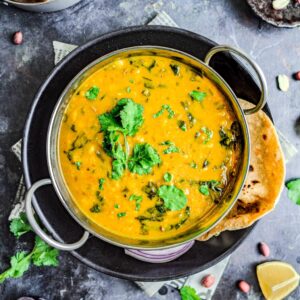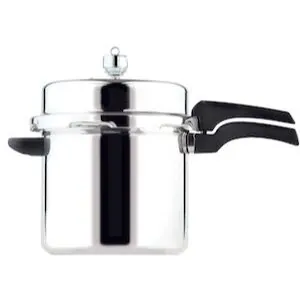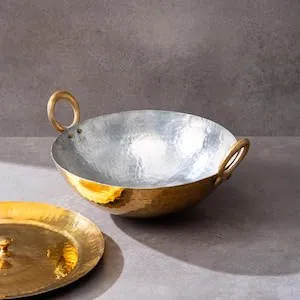
Dal Bhaji, Maharashtrian Lentil and Spinach Curry
Vidarbha special dal bhaji is made from creamy lentils, fresh spinach, raw peanuts, and a delicious mix of garlicky spices. It's vegan and GF.
Ingredients
To Cook the Dal
- 120 g plain toor dal arhar dal, tuvar dal
- 300 ml water to pressure cook
To Cook the Dal Bhaji
- 3 tablespoons oil
- ½ teaspoon mustard seeds
- 1 teaspoon cumin seeds
- 2 green finger chillies finely chopped
- 40 g red onion finely chopped
- 6 cloves garlic roughly crushed / chopped
- 40 g raw peanuts
- 40 g tomato
- 60 g spinach roughly chopped
- 1 ½ teaspoon red chilli powder
- 1 teaspoon coriander powder
- ½ teaspoon turmeric powder
- 1 teaspoon salt or to taste
- 300 ml water to further cook Dal
- ½ teaspoon jaggery grated, optional
- 1 tablespoon lemon juice
- ¼ teaspoon goda masala
Instructions
- Wash 120 g plain toor dal and drain. This is important to ensure there are no small stones.
- Add the toor dal along with 300 ml water to a pressure cooker. Set over medium heat and cook for 4 whistles. While the lentils cook, move on to the next tasks.
- In a large kadai, heat 3 tablespoons oil over medium heat. Once hot, add ½ teaspoon mustard seeds. When they pop, add 1 teaspoon cumin seeds and cook until they crackle. Next, add 2 green finger chillies (chopped), 40 g red onion (chopped), 6 cloves garlic (crushed), and 40 g raw peanuts. Cook, stirring now and then, until the mixture smells aromatic and the onions have softened.
- Next, add 40 g tomato. Stir into the mixture and cook until soft and mushy. Then add the 60 g spinach (washed and chopped), cooking until wilted.
- Add the ground spices: 1 ½ teaspoon red chilli powder, 1 teaspoon coriander powder, and ½ teaspoon turmeric powder. Stir the mixture well.
- Now add the cooked lentils. They should be soft and mushy. Immediately use a ghotni (dal ravi/dal whisk)** to beat the dal until it achieves a smooth, creamy texture.
- Adjust the consistency of the dal bhaji with around 300 ml water. Also, season with 1 teaspoon salt (or to taste), and optionally, ½ teaspoon jaggery.
- Let the dal bhaji simmer for around 10 additional minutes, or until it reaches the desired consistency. Sprinkle with ¼ teaspoon goda masala as a finishing touch, squeeze in 1 tablespoon lemon juice, and serve hot.
Notes
* Pressure cooking the lentils is the most time-effective way to cook toor dal. My preferred method involves cooking the lentils and rice (to serve) simultaneously using small pots which fit inside the pressure cooker.
Don't have a pressure cooker? No worries. Toor dal takes considerable time to cook without pressure, but it's doable. Use 700ml water (as opposed to 300ml) and cook low and slow for around 45 minutes to an hour.
** To use a ghotni, place the wooden stick between your two palms, then move your palms forwards and backwards, in opposite directions, to rotate the whisk. This works by simultaneously breaking down the dal and whisking it.
While you can use a standard metal whisk in lieu of a proper ghotni, it doesn't do quite the same job. For dal bhaji, we want a thick, smooth texture.
Nutrition
Serving: 1gCalories: 548kcalCarbohydrates: 35gProtein: 27gFat: 35gSaturated Fat: 7gPolyunsaturated Fat: 22gCholesterol: 50mgSodium: 1824mgFiber: 8gSugar: 6g
Tried this recipe?Please consider leaving a review!


